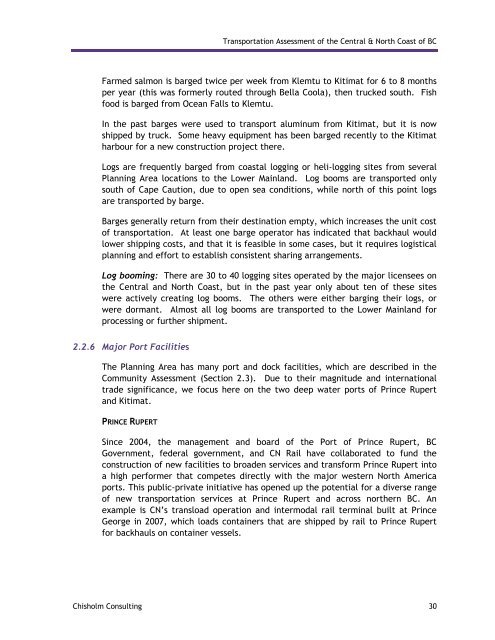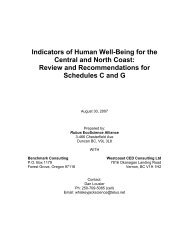Final report - Integrated Land Management Bureau
Final report - Integrated Land Management Bureau
Final report - Integrated Land Management Bureau
You also want an ePaper? Increase the reach of your titles
YUMPU automatically turns print PDFs into web optimized ePapers that Google loves.
Transportation Assessment of the Central & North Coast of BC<br />
Farmed salmon is barged twice per week from Klemtu to Kitimat for 6 to 8 months<br />
per year (this was formerly routed through Bella Coola), then trucked south. Fish<br />
food is barged from Ocean Falls to Klemtu.<br />
In the past barges were used to transport aluminum from Kitimat, but it is now<br />
shipped by truck. Some heavy equipment has been barged recently to the Kitimat<br />
harbour for a new construction project there.<br />
Logs are frequently barged from coastal logging or heli-logging sites from several<br />
Planning Area locations to the Lower Mainland. Log booms are transported only<br />
south of Cape Caution, due to open sea conditions, while north of this point logs<br />
are transported by barge.<br />
Barges generally return from their destination empty, which increases the unit cost<br />
of transportation. At least one barge operator has indicated that backhaul would<br />
lower shipping costs, and that it is feasible in some cases, but it requires logistical<br />
planning and effort to establish consistent sharing arrangements.<br />
Log booming: There are 30 to 40 logging sites operated by the major licensees on<br />
the Central and North Coast, but in the past year only about ten of these sites<br />
were actively creating log booms. The others were either barging their logs, or<br />
were dormant. Almost all log booms are transported to the Lower Mainland for<br />
processing or further shipment.<br />
2.2.6 Major Port Facilities<br />
The Planning Area has many port and dock facilities, which are described in the<br />
Community Assessment (Section 2.3). Due to their magnitude and international<br />
trade significance, we focus here on the two deep water ports of Prince Rupert<br />
and Kitimat.<br />
PRINCE RUPERT<br />
Since 2004, the management and board of the Port of Prince Rupert, BC<br />
Government, federal government, and CN Rail have collaborated to fund the<br />
construction of new facilities to broaden services and transform Prince Rupert into<br />
a high performer that competes directly with the major western North America<br />
ports. This public-private initiative has opened up the potential for a diverse range<br />
of new transportation services at Prince Rupert and across northern BC. An<br />
example is CN’s transload operation and intermodal rail terminal built at Prince<br />
George in 2007, which loads containers that are shipped by rail to Prince Rupert<br />
for backhauls on container vessels.<br />
Chisholm Consulting 30

















